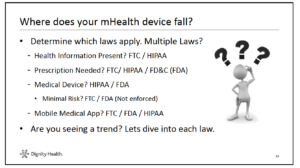Apple iPhone, iTunes… now iHealth?
CNBC recently learned of a secret team in Apple’s health unit that is working to create the iTunes of health. That is, they are working to bring users’ medical records and lab results to one centralized interface on iOS devices.
Although more than 96% of hospitals and 80% of physician practices are currently digitized — thanks, in large part, to the $30 billion spent on installing electronic records systems in hospitals and doctors’ offices since 2009 — the challenge now is to connect these systems together.
“Technology is the easy part,” Jodi Daniel, former health IT official, asserts. “The really challenging part is the business issues the operational issues and the trust issues with exchanging information,” Daniel concluded.
Apple is said to have been in talks with health IT groups that could, together, help solve some of these issues. These organizations include “The Argonaut Project,” a group of both providers and vendors seeking to promote greater interoperability of health information, and “The Carin Alliance,” which seeks to enhance consumers’ ability to obtain and share health information with caregivers.
With about one in every six dollars in the U.S. economy spent on healthcare, it’s easy to understand why Apple may be trying to break into this space. Looking at the obstacles they may have to overcome, however, it’s unclear whether they will be able to take advantage of this lucrative industry.
For one, there is a financial incentive, on behalf of doctors and hospitals, for preventing the kind of seamless sharing of medical information Apple could soon be offering. As Dr. Robert Wachter, of the University of California, San Francisco, explains: “If a doctor doesn’t have a patient’s record immediately available, the doctor may order a test that has already been done — and can bill for that test.” What’s more, “keeping EMRs from talking to each other also makes it easier to keep patients from taking their medical records — and their business — to a competing doctor,” Watcher asserts.
The root of this problem, however, may be the healthcare industry’s legacy reimbursement system. Although a 2015 study from the AMA showed that 70% of physician office visits were unnecessary and “could be mitigated by a phone call, email, or text,” in large part due to the fee-for-service model, face-to-face appointments remain more pervasive.
This was cited as a primary explanation for why Google’s medical records and health data platform was dissolved. The platform, Google Health, shut down three years after its launch in 2008 despite its partnerships with insurance companies, hospitals, prescription vendors like CVS, and its integration with Fitbit.
Microsoft’s medical information sharing service, HealthVault, however, is still in play. According to Microsoft, HealthVault is a “platform that businesses and consumers can use to store personal health information — and then generates insights from it.” The app promotes user engagement by allowing patients and providers to customize chronic care and wellness plans, and by integrating over 400 clinical and consumer devices with the app, including Fitbit. Microsoft’s HealthVault team is also currently working to enable greater interoperability between healthcare providers so more apps and users have access to medical information via the app.
A primary objective for Microsoft when launching HealthVault — which may, similarly, be one for Apple — was security. “Extra precautions at every layer of security” were installed because “privacy and security is one of the areas that Microsoft is taking very seriously for HealthVault,” a P.R. rep from Microsoft reported in 2007 when the app was released. Microsoft reports it assures users’ privacy by “build[ing] security into [their] products and services from the start,” “[using] encryption to safeguard customer data,” “[using] Microsoft cloud technology and data analytics to detect and assess threats,” among others.
Underlying these security concerns, however, is the broader issue of complying with the complex web of regulations regarding health data. According to a recent presentation to the Health Care Compliance Association, medical health apps — which are “any application that can be run on a mobile platform with or without wireless (internet) connectivity,” including “any application that is running as a software as a service (e.g. hosted on a server and is customized to run on a portable or mobile device)” — must comply with numerous laws that vary depending on the precise services offered. This slide sums it up nicely:
 Google Health, which tried to make it “…easier to schedule appointments and communicate with doctors” and permit patients to “manage medications remotely,” thus had to navigate multiple regulatory and privacy issues to build this integrated platform.
Google Health, which tried to make it “…easier to schedule appointments and communicate with doctors” and permit patients to “manage medications remotely,” thus had to navigate multiple regulatory and privacy issues to build this integrated platform.
A new regulatory approach to such medical devices may be in place by the time Apple’s health app hits the market. The FDA recently announced a “new Digital Health Innovation Plan” focused on “fostering innovation at the intersection of medicine and digital health technology” is in the works. The plan will include a “novel, post-market approach to how we [the FDA] intend to regulate these digital medical devices” and will provide greater clarity and guidance on which devices are within the scope of FDA regulation. This pilot program is still being developed, but is set to release later this year.








